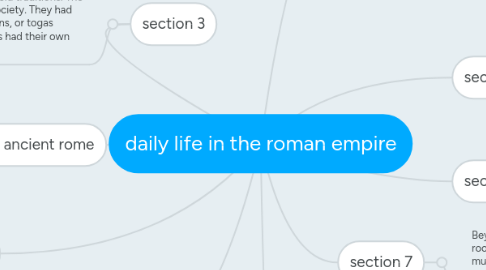daily life in the roman empire
by SIERRA HITCHCOCK

1. section 2 daily life in ancient rome
1.1. most people in the 1st century in ancient Rome lived in crammed small apartments on the streets. Wealthy women shopped for goods with their slaves, and senators walk with their body guards. Wealthy Romans spent most of their money on silks, perfumes, jeweled weapons and musical instruments. the rich were only a small part of Romes population.
2. section 3
2.1. Even in the empire, however, Romans honored some of their old traditions. The Senate continued to meet, and senators had high status in society. They had their own styles of clothing. They might wear special rings, pins, or togas (robes) trimmed with a wide purple stripe. Important senators had their own bodyguard.
3. section 9
3.1. Roman emperors made sure to give the poor “bread and circuses”—food and entertainment—to keep them busy and happy. Besides the many festivals throughout the year, rich and poor alike flocked to two spectacles: gladiator contests and chariot races.
4. section 10
4.1. Rome was one of many cities scattered throughout the Roman Empire. But 90 percent of the empire’s people lived in the country. There, too, rich and poor had very different lives.
5. section 4
5.1. Romans wanted to please their gods because they believed that the gods controlled their daily lives. At Rome’s many temples and shrines, people made offerings and promises to the gods. They often left gifts of food, such as honey cakes and fruit. They also sacrificed animals, including bulls, sheep, and oxen.
6. section 5
6.1. Roman men were expected to provide for the family. In richer families, husbands often held well-paid political positions. In poor families, both husbands and wives had to work in order to feed and care for themselves and their children. Wealthy Roman women ran their households. They bought and trained the family’s slaves. Many had money of their own and were active in business. They bought and sold property.
7. section 6
7.1. What Romans cooked and ate depended on whether they were rich or poor. Only the rich had kitchens in their homes. The poor cooked on small grills and depended on “fast-food” places called thermopolia, where people could buy hot and cold foods that were ready to eat. Even the rich often bought their daytime meals at thermopolia because the service was fast and convenient.
8. section 7
8.1. Beyond the atrium, there were many rooms for the family and guests. The fanciest room was the dining room. Its walls were covered in pictures, both painted murals and mosaics made of tiles. Mosaics also decorated the floors. Graceful statues stood in the corners. Some dining rooms had beautiful fountains in the center to provide guests with cool water.
9. section 8
9.1. In wealthier families, boys and girls were tutored by their fathers, or often by slaves, until they were about six years old. Then boys went off to school. Classes were held in public buildings and private homes. Many of the tutors were educated Greek slaves.


